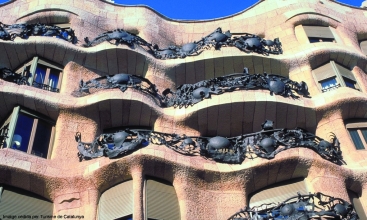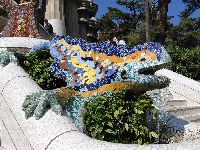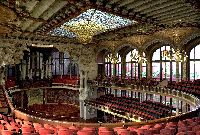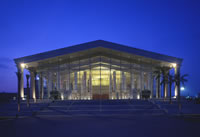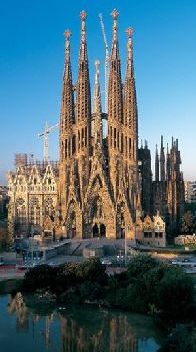

Architecture 
The predominant artistic styles in Europe have been evolving and changing for centuries. The first great cathedrals and mediaeval monasteries were Romanesque, a style with deep roots in Catalonia, and this developed into the splendour of Gothic, of which many examples are to be seen in our cities, especially in Barcelona. The small, Romanesque churches of the Pyrenees deserve special mention; they have, furthermore, bequeathed us a rich heritage of frescoes, mostly kept at the Museu Nacional d’Art de Catalunya.
We find interesting examples of Renaissance, Baroque and neo-Classical architecture throughout the country, but it is Modernisme, which emerged during the late 19th century during a period of economic and demographic expansion, that presents itself as the nation’s artistic style. The Modernista movement placed great importance on the decorative arts and it became the most outstanding artistic movement of the day.
Antoni Gaudí (1852-1926), the most exceptional and internationally recognised figure, was so extraordinary that he transcended the limits of this artistic movement. His works include such gems as the Sagrada Família, the Park Güell, the Casa Milà—known as La Pedrera—, and the Casa Batlló in Barcelona, as well as the crypt at the Colònia Güell in Santa Coloma de Cervelló.
Among the other outstanding architects in this movement were Lluís Domènech i Montaner (1850-1923), one of the fathers of Modernisme and the architect who designed the Palau de la Música Catalana and the Hospital de Sant Pau in Barcelona; Josep M. Jujol (1879-1949), whose architectural work was mainly concentrated in the Camp de Tarragona area; Cèsar Martinell (1888-1973), famous for his agricultural buildings, especially the wine cellars known as the “cathedrals of wine”; and Lluís Muncunill (1868-1931), who adapted the Modernista style to industrial architecture in Terrassa. Josep Puig i Cadafalch (1867-1957), whose works include the Casa Amatller and the Casa Terrades—popularly known as the Casa de les Punxes—was the movement’s last great representative.
Architectural rationalism and the influence of Le Corbusier were brought to Catalonia by Josep Lluís Sert (1902-1983), the best known member of the GATPAC - Grup d’Arquitectes i Tècnics Catalans pel Progrés de l’Arquitectura Contemporània (Group of Catalan Architects and Technicians for the Progress of Contemporary Architecture). This group, founded in 1928 but brought to an early end in 1939, represented an avant-garde approach to thinking about buildings and urban planning. Josep Torres Clavé (1906-1939) and Ricardo de Churruca (1900-1963), amongst others, were also members.
Josep Antoni Coderch (1913-1984) was the most internationally renowned, post-war Catalan architect. During the first decade after the restoration of democracy a generation of architects became consolidated who would transform Barcelona for the 1992 Olympic Games, amongst them Oriol Bohigas (1925), David-John Mackay (1933) and Josep Martorell (1925) of the MBM Studio (Vila Olímpica); Ricard Bofill (1939) (Teatre Nacional de Catalunya); Òscar Tusquets (1941) (refurbishment and extension of the Palau de la Música Catalana); Lluís Clotet (1941), Carlos Ferrater (1944); Rosa Barba (1948-2000) and Ricard Pié (1946) of the Barba & Pié studio; Josep Lluís Mateo (1949); Lluís Doménech (1940) and Roser Amadó (1944), the veteran team of B01 Arquitectes, with works such as the Fundació Tàpies; and Carme Pinós (1954).
Enric Miralles (1955-2000), the most internationally recognized Catalan architect during the last years of the 20th century, also deserves mention with exemplary works such as the Igualada cemetery and the refurbishment of the Santa Caterina market in Barcelona. Since his death, his partner Benedetta Tagliabue (1963) has continued at the for a the Miralles & Tagliabue studio carrying out some of the projects they started together such as the headquarters for the Gas Natural company.
The architectural leap forward which the Barcelona’92 Olympic Games meant for the city – one that would make Barcelona a point of reference around the world – was also made possible through the work of numerous other world-class architects such as Arata Isozaki (Palau Sant Jordi), Norman Foster (Torre Collserola), Frank O. Gehry (Fish), Santiago Calatrava (Montjuïc Communications Tower), Peter Eisenman (Olympic Village and the Parc de la Draga in Banyoles) and Richard Meyer (Museu d’Art Contemporani de Barcelona, MACBA). In the architectural transformation that has been taking place over the first years of the new century, with the 2004 Forum of the Cultures as the driving motor, new international names have appeared on the scene such as Herzog and De Meuron (Edifici Fòrum); Jean Nouvel (Torre Agbar); and Iñaki Ábalos and Juan Herreros (Parc Litoral del Fòrum). International architects are also playing a role in designing Catalonia’s architectural future with Toyo Ito, who is working on a project to extend the Fira de Barcelona Montjuïc-2 (Barcelona Trade Fair); Zaha Hadid, who will build the Spiralling Tower, the future Besòs university campus building; David Chipperfield, who has designed the Ciutat de la Justícia in Hospitalet de Llobregat, and Dominique Perrault, who is working on the sports complex and the future Montigalà Stadium in Badalona.
